Energy Savings in the Heat Exchanger Network of an Oil Refinery Pre-Heat Train Unit Using a Path’s Combination at Different HRAT Values
Abstract
1. Introduction
Historical Review
2. Methodology
2.1. Exchangers and Utility Data
2.2. Utility Path Identification and Combination for Existing HEN
2.3. Heat Load Shifting Using Combined Paths
2.4. Pinch Technology Targeting
Economic Assessment
- Investment was considered only for the required added area.
- No piping or other costs were considered.
3. Results and Analysis
3.1. Area Targeting
3.2. Cost Targeting
Cost-Effective Analysis
4. Conclusions
Author Contributions
Funding
Institutional Review Board Statement
Informed Consent Statement
Data Availability Statement
Acknowledgments
Conflicts of Interest
Appendix A
| HRAT (°C) | QE1 (kW) | QE2 (kW) | QE3 (kW) | QE4 (kW) | QE5 (kW) | QE6 (kW) | Total (kW) |
|---|---|---|---|---|---|---|---|
| Existing | 22,000 | 38,480 | 15,000 | 7500 | 23,000 | 6000 | 111,980 |
| 2 | 22,001 | 38,480 | 20,341 | 7500 | 23,000 | 6000 | 117,322 |
| 4 | 22,001 | 38,480 | 20,112 | 7500 | 23,000 | 6000 | 117,093 |
| 6 | 22,001 | 38,480 | 19,884 | 7500 | 23,000 | 6000 | 116,865 |
| 8 | 22,001 | 38,480 | 19,655 | 7500 | 23,000 | 6000 | 116,636 |
| 10 | 22,001 | 38,480 | 19,426 | 7500 | 23,000 | 6000 | 116,407 |
| 12 | 22,001 | 38,480 | 19,197 | 7500 | 23,000 | 6000 | 116,178 |
| 14 | 22,001 | 38,480 | 18,968 | 7500 | 23,000 | 6000 | 115,949 |
| 16 | 22,001 | 38,480 | 18,740 | 7500 | 23,000 | 6000 | 115,721 |
| 18 | 22,001 | 38,480 | 18,511 | 7500 | 23,000 | 6000 | 115,492 |
| 20 | 22,001 | 38,480 | 18,282 | 7500 | 23,000 | 6000 | 115,263 |
| 22 | 22,001 | 38,480 | 18,053 | 7500 | 23,000 | 6000 | 115,034 |
| 24 | 22,001 | 38,480 | 17,824 | 7500 | 23,000 | 6000 | 114,805 |
| 26 | 22,001 | 38,480 | 17,594 | 7500 | 23,000 | 6000 | 114,575 |
| 28 | 22,001 | 38,480 | 17,367 | 7500 | 23,000 | 6000 | 114,348 |
| 30 | 22,001 | 38,480 | 17,138 | 7500 | 23,000 | 6000 | 114,119 |
| HRAT (°C) | QE1 (kW) | QE2 (kW) | QE3 (kW) | QE4 (kW) | QE5 (kW) | QE6 (kW) | Total (kW) |
|---|---|---|---|---|---|---|---|
| Existing | 22,000 | 38,480 | 15,000 | 7500 | 23,000 | 6000 | 111,980 |
| 2 | 22,000 | 38,480 | 15,000 | 7500 | 23,000 | 9449 | 115,429 |
| 4 | 22,000 | 38,480 | 15,000 | 7500 | 23,000 | 9329 | 115,309 |
| 6 | 22,000 | 38,480 | 15,000 | 7500 | 23,000 | 9209 | 115,189 |
| 8 | 22,000 | 38,480 | 15,000 | 7500 | 23,000 | 9090 | 115,070 |
| 10 | 22,000 | 38,480 | 15,000 | 7500 | 23,000 | 8970 | 114,950 |
| 12 | 22,000 | 38,480 | 15,000 | 7500 | 23,000 | 8851 | 114,831 |
| 14 | 22,000 | 38,480 | 15,000 | 7500 | 23,000 | 8731 | 114,711 |
| 16 | 22,000 | 38,480 | 15,000 | 7501 | 23,001 | 8611 | 114,593 |
| 18 | 22,000 | 38,480 | 15,000 | 7501 | 23,001 | 8492 | 114,474 |
| 20 | 22,000 | 38,480 | 15,000 | 7501 | 23,001 | 8372 | 114,354 |
| 22 | 22,000 | 38,480 | 15,000 | 7501 | 23,001 | 8253 | 114,235 |
| 24 | 22,000 | 38,480 | 15,000 | 7501 | 23,001 | 8133 | 114,115 |
| 26 | 22,000 | 38,480 | 15,000 | 7501 | 23,001 | 8013 | 113,995 |
| 28 | 22,000 | 38,480 | 15,000 | 7501 | 23,001 | 7894 | 113,876 |
| 30 | 22,000 | 38,480 | 15,000 | 7501 | 23,001 | 7774 | 113,756 |
| HRAT (°C) | QE1 (kW) | QE2 (kW) | QE3 (kW) | QE4 (kW) | QE5 (kW) | QE6 (kW) | Total (kW) |
|---|---|---|---|---|---|---|---|
| Existing | 22,000 | 38,480 | 15,000 | 7500 | 23,000 | 6000 | 111,980 |
| 2 | 27,693 | 38,480 | 15,000 | 7500 | 22,999 | 3279 | 114,951 |
| 4 | 27,289 | 38,480 | 15,000 | 7500 | 22,999 | 3683 | 114,951 |
| 6 | 26,885 | 38,480 | 15,000 | 7500 | 22,999 | 4047 | 114,911 |
| 8 | 26,480 | 38,480 | 15,000 | 7500 | 22,999 | 4492 | 114,951 |
| 10 | 26,075 | 38,480 | 15,000 | 7500 | 23,000 | 4896 | 114,951 |
| 12 | 25,717 | 38,480 | 15,000 | 7500 | 23,000 | 5135 | 114,832 |
| 14 | 25,359 | 38,480 | 15,000 | 7500 | 23,000 | 5373 | 114,712 |
| 16 | 25,002 | 38,480 | 15,000 | 7500 | 23,000 | 5610 | 114,592 |
| 18 | 24,643 | 38,480 | 15,000 | 7500 | 23,000 | 5850 | 114,473 |
| 20 | 24,286 | 38,480 | 15,000 | 7500 | 23,000 | 6087 | 114,353 |
| 22 | 23,927 | 38,480 | 15,000 | 7500 | 23,000 | 6327 | 114,234 |
| 24 | 23,575 | 38,480 | 15,000 | 7500 | 23,000 | 6564 | 114,119 |
| 26 | 23,212 | 38,480 | 15,000 | 7500 | 23,000 | 6802 | 113,994 |
| 28 | 22,854 | 38,480 | 15,000 | 7500 | 23,000 | 7041 | 113,875 |
| 30 | 22,496 | 38,480 | 15,000 | 7500 | 23,000 | 7279 | 113,755 |
| HRAT (°C) | QE1 (kW) | QE2 (kW) | QE3 (kW) | QE4 (kW) | QE5 (kW) | QE6 (kW) | Total (kW) |
|---|---|---|---|---|---|---|---|
| Existing | 22,000 | 38,480 | 15,000 | 7500 | 23,000 | 6000 | 111,980 |
| 2 | 22,000 | 38,480 | 15,000 | 7500 | 23,000 | 9449 | 115,429 |
| 4 | 22,000 | 38,480 | 15,000 | 7500 | 23,000 | 9329 | 115,309 |
| 6 | 22,000 | 38,480 | 15,000 | 7500 | 23,000 | 9209 | 115,189 |
| 8 | 22,000 | 38,480 | 15,000 | 7500 | 23,000 | 9090 | 115,070 |
| 10 | 22,001 | 38,480 | 15,001 | 7501 | 23,001 | 8970 | 114,950 |
| 12 | 22,001 | 38,480 | 15,001 | 7501 | 23,001 | 8851 | 114,831 |
| 14 | 22,001 | 38,480 | 15,001 | 7501 | 23,001 | 8731 | 114,711 |
| 16 | 22,001 | 38,480 | 15,001 | 7501 | 23,001 | 8611 | 114,595 |
| 18 | 22,001 | 38,480 | 15,001 | 7501 | 23,001 | 8492 | 114,476 |
| 20 | 22,001 | 38,480 | 15,001 | 7501 | 23,001 | 8372 | 114,356 |
| 22 | 22,001 | 38,480 | 15,001 | 7501 | 23,001 | 8253 | 114,237 |
| 24 | 22,001 | 38,480 | 15,001 | 7501 | 23,001 | 8133 | 114,117 |
| 26 | 22,001 | 38,480 | 15,001 | 7501 | 23,001 | 8013 | 113,997 |
| 28 | 22,001 | 38,480 | 15,001 | 7501 | 23,001 | 7894 | 113,878 |
| 30 | 22,001 | 38,480 | 15,001 | 7501 | 23,001 | 7774 | 113,758 |
| HRAT (°C) | QE1 (kW) | QE2 (kW) | QE3 (kW) | QE4 (kW) | QE5 (kW) | QE6 (kW) | Total (kW) |
|---|---|---|---|---|---|---|---|
| Existing | 22,000 | 38,480 | 15,000 | 7500 | 23,000 | 6000 | 111,980 |
| 2 | 22,001 | 38,480 | 21,011 | 7501 | 23,001 | 2961 | 114,955 |
| 4 | 22,001 | 38,480 | 20,718 | 7501 | 23,001 | 3254 | 114,955 |
| 6 | 22,001 | 38,480 | 20,424 | 7501 | 23,001 | 3548 | 114,955 |
| 8 | 22,001 | 38,480 | 20,131 | 7501 | 23,001 | 3841 | 114,955 |
| 10 | 22,001 | 38,480 | 19,837 | 7500 | 23,000 | 4133 | 114,951 |
| 12 | 22,001 | 38,480 | 19,598 | 7501 | 23,001 | 4274 | 114,955 |
| 14 | 22,001 | 38,480 | 19,318 | 7501 | 23,001 | 4414 | 114,715 |
| 16 | 22,001 | 38,480 | 19,059 | 7501 | 23,001 | 4553 | 114,595 |
| 18 | 22,001 | 38,480 | 18,799 | 7501 | 23,001 | 4694 | 114,476 |
| 20 | 22,001 | 38,480 | 18,540 | 7501 | 23,001 | 4833 | 114,356 |
| 22 | 22,001 | 38,480 | 18,280 | 7501 | 23,001 | 4974 | 114,237 |
| 24 | 22,001 | 38,480 | 18,020 | 7501 | 23,001 | 5114 | 114,117 |
| 26 | 22,001 | 38,480 | 17,761 | 7501 | 23,001 | 5253 | 113,997 |
| 28 | 22,001 | 38,480 | 17501 | 7501 | 23,001 | 5394 | 113,878 |
| 30 | 22,001 | 38,480 | 17,242 | 7501 | 23,001 | 5533 | 113,758 |
Appendix B
| HRAT (°C) | QC1 (kW) | QC2 (kW) | QC3 (kW) | QC4 (kW) | QC5 (kW) | QH (kW) | Total (kW) |
|---|---|---|---|---|---|---|---|
| Existing | 2970 | 11,312 | 3316 | 26,048 | 9890 | 80,418 | 133,954 |
| 2 | 2970 | 5971 | 3316 | 26,047 | 9890 | 75,076 | 123,272 |
| 4 | 2970 | 6200 | 3316 | 26,047 | 9890 | 75,305 | 123,728 |
| 6 | 2970 | 6428 | 3316 | 26,047 | 9890 | 75,533 | 124,184 |
| 8 | 2970 | 6657 | 3316 | 26,047 | 9890 | 75,762 | 124,642 |
| 10 | 2970 | 6886 | 3316 | 26,047 | 9890 | 75,991 | 125,100 |
| 12 | 2970 | 7115 | 3316 | 26,047 | 9890 | 76,220 | 125,558 |
| 14 | 2970 | 7344 | 3316 | 26,047 | 9890 | 76,449 | 126,016 |
| 16 | 2970 | 7572 | 3316 | 26,047 | 9890 | 76,677 | 126,472 |
| 18 | 2970 | 7801 | 3316 | 26,047 | 9890 | 76,906 | 126,930 |
| 20 | 2970 | 8030 | 3316 | 26,047 | 9890 | 77,135 | 127,388 |
| 22 | 2970 | 8259 | 3316 | 26,047 | 9890 | 77,364 | 127,846 |
| 24 | 2970 | 8488 | 3316 | 26,047 | 9890 | 77,593 | 128,304 |
| 26 | 2970 | 8716 | 3316 | 26,047 | 9890 | 77,821 | 128,760 |
| 28 | 2970 | 8945 | 3316 | 26,047 | 9890 | 78,050 | 129,218 |
| 30 | 2970 | 9174 | 3316 | 26,047 | 9890 | 78,279 | 129,676 |
| HRAT (°C) | QC1 (kW) | QC2 (kW) | QC3 (kW) | QC4 (kW) | QC5 (kW) | QH (kW) | Total (kW) |
|---|---|---|---|---|---|---|---|
| Existing | 2970 | 11,312 | 3316 | 26,048 | 9890 | 80,418 | 133,954 |
| 2 | −479 | 11,312 | 3316 | 26,048 | 9890 | 77,448 | 127,535 |
| 4 | −359 | 11,312 | 3316 | 26,048 | 9890 | 77,448 | 127,655 |
| 6 | −239 | 11,312 | 3316 | 26,048 | 9890 | 77,448 | 127,775 |
| 8 | −120 | 11,312 | 3316 | 26,048 | 9890 | 77,448 | 127,894 |
| 10 | 0 | 11,312 | 3315 | 26,048 | 9889 | 77,446 | 128,010 |
| 12 | 119 | 11,312 | 3315 | 26,048 | 9889 | 77,565 | 128,248 |
| 14 | 239 | 11,312 | 3315 | 26,048 | 9889 | 77,685 | 128,488 |
| 16 | 359 | 11,312 | 3315 | 26,048 | 9889 | 77,805 | 128,728 |
| 18 | 478 | 11,312 | 3315 | 26,048 | 9889 | 77,924 | 128,966 |
| 20 | 598 | 11,312 | 3315 | 26,048 | 9889 | 78,044 | 129,206 |
| 22 | 717 | 11,312 | 3315 | 26,048 | 9889 | 78,163 | 129,444 |
| 24 | 837 | 11,312 | 3315 | 26,048 | 9889 | 78,283 | 129,684 |
| 26 | 957 | 11,312 | 3315 | 26,048 | 9889 | 78,403 | 129,924 |
| 28 | 1076 | 11,312 | 3315 | 26,048 | 9889 | 78,522 | 130,162 |
| 30 | 1196 | 11,312 | 3315 | 26,048 | 9889 | 78,642 | 130,402 |
| HRAT (°C) | QC1 (kW) | QC2 (kW) | QC3 (kW) | QC4 (kW) | QC5 (kW) | QH (kW) | Total (kW) |
|---|---|---|---|---|---|---|---|
| Existing | 2970 | 11,312 | 3316 | 26,048 | 9890 | 80,418 | 133,954 |
| 2 | 5691 | 11,312 | 3316 | 20,356 | 9890 | 77,448 | 128,013 |
| 4 | 5287 | 11,312 | 3316 | 20,759 | 9891 | 77,448 | 128,013 |
| 6 | 4883 | 11,312 | 3316 | 21,163 | 9891 | 77,448 | 128,013 |
| 8 | 4478 | 11,312 | 3316 | 21,568 | 9891 | 77,448 | 128,013 |
| 10 | 4074 | 11,312 | 3316 | 21,973 | 9890 | 77,448 | 128,013 |
| 12 | 3835 | 11,312 | 3316 | 22,331 | 9890 | 77,566 | 128,250 |
| 14 | 3597 | 11,312 | 3316 | 22,689 | 9890 | 77,686 | 128,490 |
| 16 | 3360 | 11,312 | 3316 | 23,046 | 9890 | 77,806 | 128,730 |
| 18 | 3120 | 11,312 | 3316 | 23,405 | 9890 | 77,925 | 128,968 |
| 20 | 2883 | 11,312 | 3316 | 23,762 | 9890 | 78,045 | 129,208 |
| 22 | 2643 | 11,312 | 3316 | 24,121 | 9890 | 78,164 | 129,446 |
| 24 | 2406 | 11,312 | 3316 | 24,478 | 9890 | 78,284 | 129,686 |
| 26 | 2168 | 11,312 | 3316 | 24,836 | 9890 | 78,404 | 129,926 |
| 28 | 1929 | 11,312 | 3316 | 25,194 | 9890 | 78,523 | 130,164 |
| 30 | 1691 | 11,312 | 3316 | 25,552 | 9890 | 78,643 | 130,404 |
| HRAT (°C) | QC1 (kW) | QC2 (kW) | QC3 (kW) | QC4 (kW) | QC5 (kW) | QH (kW) | Total (kW) |
|---|---|---|---|---|---|---|---|
| Existing | 2970 | 11,312 | 3316 | 26,048 | 9890 | 80,418 | 133,954 |
| 2 | −479 | 11,312 | 3316 | 26,048 | 9890 | 77,448 | 127,535 |
| 4 | −359 | 11,312 | 3316 | 26,048 | 9890 | 77,448 | 127,655 |
| 6 | −239 | 11,312 | 3316 | 26,048 | 9890 | 77,448 | 127,775 |
| 8 | −120 | 11,312 | 3316 | 26,048 | 9890 | 77,448 | 127,894 |
| 10 | 0 | 11,312 | 3315 | 26,047 | 9889 | 77,444 | 128,007 |
| 12 | 119 | 11,312 | 3315 | 26,047 | 9889 | 77,563 | 128,245 |
| 14 | 239 | 11,312 | 3315 | 26,047 | 9889 | 77,683 | 128,485 |
| 16 | 359 | 11,312 | 3315 | 26,047 | 9889 | 77,803 | 128,725 |
| 18 | 478 | 11,312 | 3315 | 26,047 | 9889 | 77,922 | 128,963 |
| 20 | 598 | 11,312 | 3315 | 26,047 | 9889 | 78,042 | 129,203 |
| 22 | 717 | 11,312 | 3315 | 26,047 | 9889 | 78,161 | 129,441 |
| 24 | 837 | 11,312 | 3315 | 26,047 | 9889 | 78,281 | 129,681 |
| 26 | 957 | 11,312 | 3315 | 26,047 | 9889 | 78,401 | 129,921 |
| 28 | 1076 | 11,312 | 3315 | 26,047 | 9889 | 78,520 | 130,159 |
| 30 | 1196 | 11,312 | 3315 | 26,047 | 9889 | 78,640 | 130,399 |
| HRAT (°C) | QC1 (kW) | QC2 (kW) | QC3 (kW) | QC4 (kW) | QC5 (kW) | QH (kW) | Total (kW) |
|---|---|---|---|---|---|---|---|
| Existing | 2970 | 11,312 | 3316 | 26,048 | 9890 | 80,418 | 133,954 |
| 2 | 6009 | 5301 | 3315 | 26,047 | 9889 | 77,444 | 128,005 |
| 4 | 5716 | 5594 | 3315 | 26,047 | 9889 | 77,444 | 128,005 |
| 6 | 5422 | 5888 | 3315 | 26,047 | 9889 | 77,444 | 128,005 |
| 8 | 5129 | 6181 | 3315 | 26,047 | 9889 | 77,444 | 128,005 |
| 10 | 4837 | 6475 | 3316 | 26,048 | 9890 | 77,448 | 128,014 |
| 12 | 4696 | 6734 | 3315 | 26,047 | 9889 | 77,563 | 128,244 |
| 14 | 4556 | 6994 | 3315 | 26,047 | 9889 | 77,683 | 128,484 |
| 16 | 4417 | 7253 | 3315 | 26,047 | 9889 | 77,803 | 128,724 |
| 18 | 4276 | 7513 | 3315 | 26,047 | 9889 | 77,922 | 128,962 |
| 20 | 4137 | 7772 | 3315 | 26,047 | 9889 | 78,042 | 129,202 |
| 22 | 3996 | 8032 | 3315 | 26,047 | 9889 | 78,161 | 129,440 |
| 24 | 3856 | 8292 | 3315 | 26,047 | 9889 | 78,281 | 129,680 |
| 26 | 3717 | 8551 | 3315 | 26,047 | 9889 | 78,401 | 129,920 |
| 28 | 3576 | 8811 | 3315 | 26,047 | 9889 | 78,520 | 130,158 |
| 30 | 3437 | 9070 | 3315 | 26,047 | 9889 | 78,640 | 130,398 |
References
- Linnhoff, B.; Flower, J. Synthesis of heat exchanger networks: Synthesis of heat exchanger networks: II. Evolutionary generation of networks with various criteria of optimality. AICHE J. 1978, 24, 642–654. [Google Scholar] [CrossRef]
- March, L. Introduction to pinch technology. In Targeting House; Targeting House: Cheshire, England, 1998. [Google Scholar]
- Telang, K.; Knopf, F.C.; Pike, R.W. The Heat Exchanger Network; Mineral Processing Research Institute: Baton Rouge, LA, USA, 2001. [Google Scholar]
- Smith, R. Chemical Process: Design and Integration; John Wiley & Sons: New York, NY, USA, 2005. [Google Scholar]
- Pejpichestakula, W.; Siemanond, K. Retrofit of refinery heat exchanger network under different kinds of crude oil by pinch design method using mathematical programming. Chem. Eng. 2013, 32, 1332236. [Google Scholar]
- Linnhoff, B.; Ahmad, S. Cost optimum heat exchanger networks—1: Minimum energy and capital using simple models for capital cost. Comput. Chem. Eng. 1990, 14, 729–750. [Google Scholar] [CrossRef]
- Zhu, X.; O’Neill, B.; Roach, J.; Wood, R. A new method for heat exchanger network synthesis using area targeting procedures. Comput. Chem. Eng. 1995, 19, 197–222. [Google Scholar] [CrossRef]
- Siemanond, K.; Kosol, S. Heat exchanger network retrofit by pinch design method using stage-model mathematical programming. Chem. Eng. Trans. 2012, 29, 367–372. [Google Scholar]
- Ahmad, S.; Linnhoff, B.; Smith, R. Cost optimum heat exchanger networks—2: Targets and design for detailed capital cost models. Comput. Chem. Eng. 1990, 14, 751–767. [Google Scholar] [CrossRef]
- Osman, A.; Mutalib, M.A.; Shuhaimi, M.; Amminudin, K. Paths combination for HENs retrofit. Appl. Therm. Eng. 2009, 29, 3103–3109. [Google Scholar] [CrossRef]
- Osman, A.; Mutalib, M.A.; Shigidi, I. Heat recovery enhancement in HENs using a combinatorial approach of paths combination and process streams’ temperature flexibility. S. Afr. J. Chem. Eng. 2016, 21, 37–48. [Google Scholar] [CrossRef][Green Version]
- Osman, A.; Eltayeb, M.; Rajab, F. Utility paths combination in HEN for energy saving and CO2 emission reduction. Processes 2019, 7, 425. [Google Scholar] [CrossRef]
- Alhajri, I.H.; Gadalla, M.A.; Elazab, H.A. A conceptual efficient design of energy recovery systems using a new energy-area key parameter. Energy Rep. 2021, 7, 1079–1090. [Google Scholar] [CrossRef]
- Zhang, D.; Li, Y.; Sun, H.; Liu, G. Energy recovery enhancement of heat exchanger network by mixing and azeotrope formation. Chem. Eng. Sci. 2020, 228, 115992. [Google Scholar] [CrossRef]
- Li, N.; Wang, J.; Klemeš, J.J.; Wang, Q.; Varbanov, P.S.; Yang, W.; Liu, X.; Zeng, M. A target-evaluation method for heat exchanger network optimisation with heat transfer enhancement. Energy Convers. Manag. 2021, 238, 114154. [Google Scholar] [CrossRef]
- Ong, B.H.; Walmsley, T.G.; Atkins, M.J.; Varbanov, P.S.; Walmsley, M.R. A heat-and mass-integrated design of hydrothermal liquefaction process co-located with a Kraft pulp mill. Energy 2019, 189, 116235. [Google Scholar] [CrossRef]
- Orosz, Á.; How, B.S.; Friedler, F. Multiple-solution heat exchanger network synthesis using P-HENS solver. J. Taiwan Inst. Chem. Eng. 2021, 130, 103859. [Google Scholar] [CrossRef]
- Alhajri, I.H.; Gadalla, M.A.; Abdelaziz, O.Y.; Ashour, F.H. Retrofit of heat exchanger networks by graphical Pinch Analysis–A case study of a crude oil refinery in Kuwait. Case Stud. Therm. Eng. 2021, 26, 101030. [Google Scholar] [CrossRef]
- Fu, D.; Yu, Z.; Lai, Y. Linking pinch analysis and shifted temperature driving force plot for analysis and retrofit of heat exchanger network. J. Clean. Prod. 2021, 315, 128235. [Google Scholar] [CrossRef]
- Panjeshahi, M.; Tahouni, N. Pressure drop optimisation in debottlenecking of heat exchanger networks. Energy 2008, 33, 942–951. [Google Scholar] [CrossRef]
- Ibrahim, M.A.M. Energy Optimization and Retrofit of Heat Exchanger Networks Case Study: Preheat-Train of the Crude Distillation Unit; University of Gezira: Wad Madani, Sudan, 2013. [Google Scholar]
- Elsiddig, A.O. Path Analysis for the Retrofit of Heat Exchanger Networks and the Utility System. Ph.D. Thesis, UTP, Seri Iskandar, Malaysia, 2011. [Google Scholar]
- Al-Riyami, B.A.; Klemes, J.; Perry, S. Heat Integration Retrofit Analysis of a Heat Exchanges Network of a Fluid Catalytic Cracking Plant. Appl. Therm. Eng. 2001, 21, 449–1487. [Google Scholar] [CrossRef]
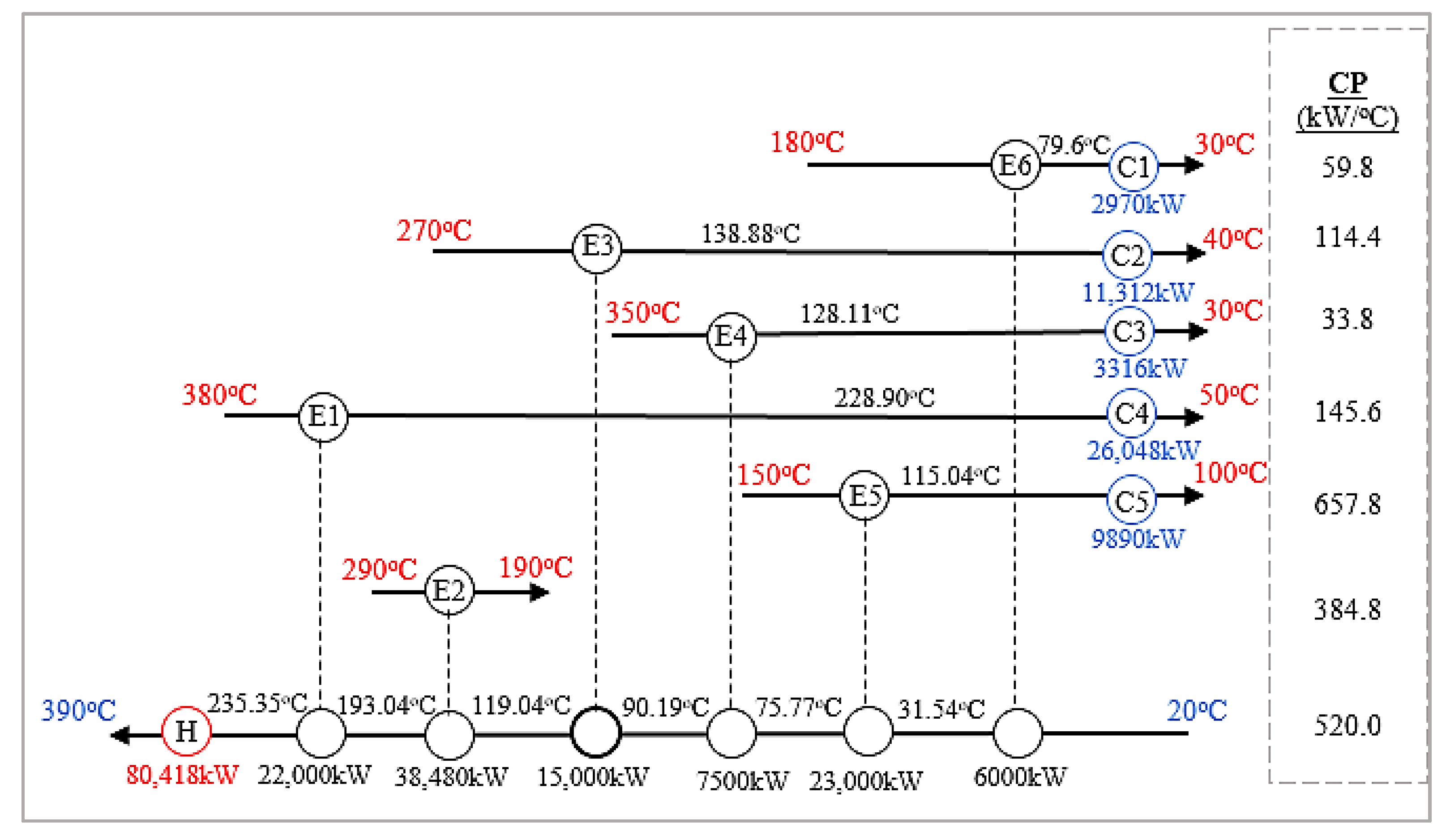
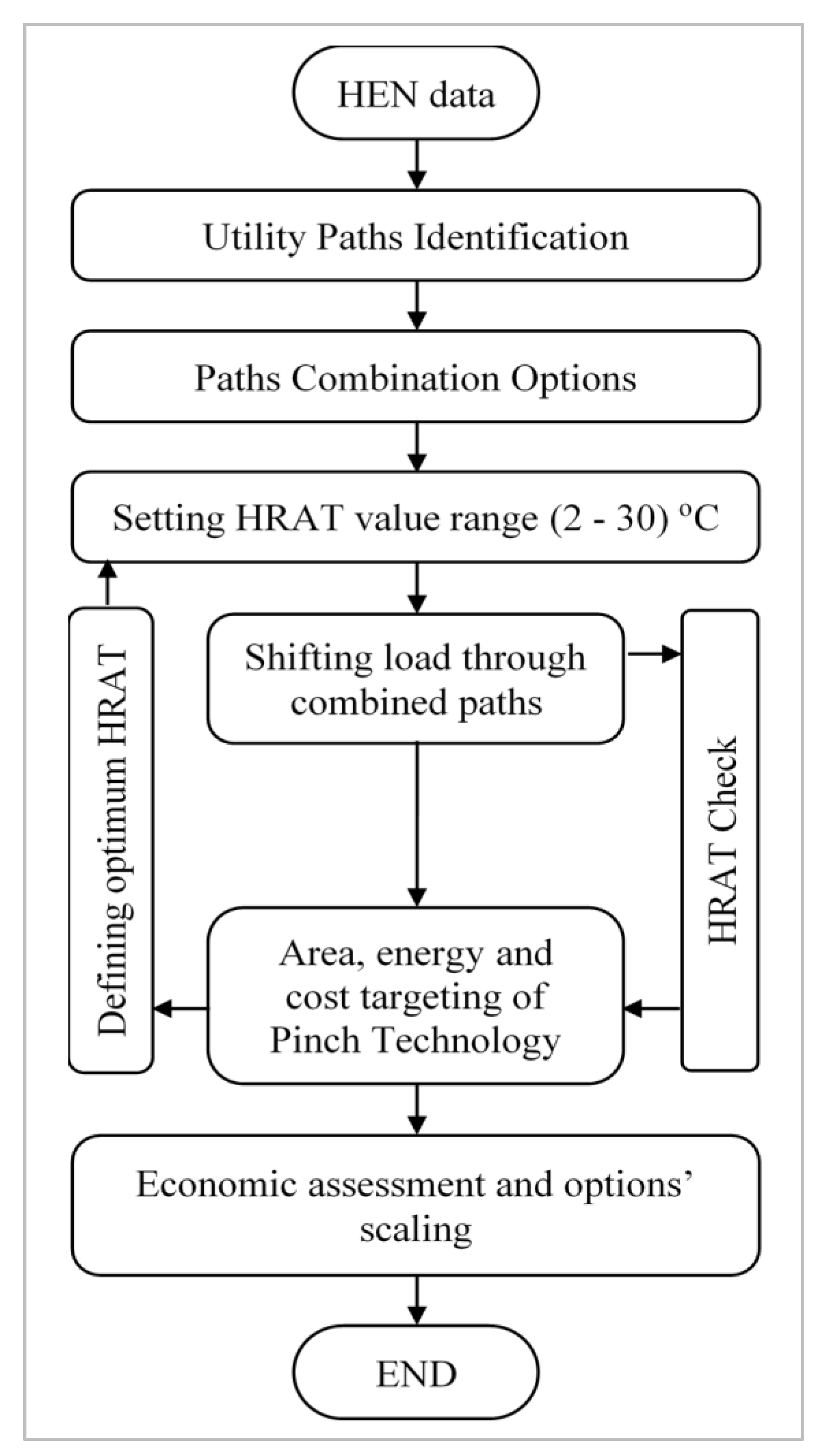

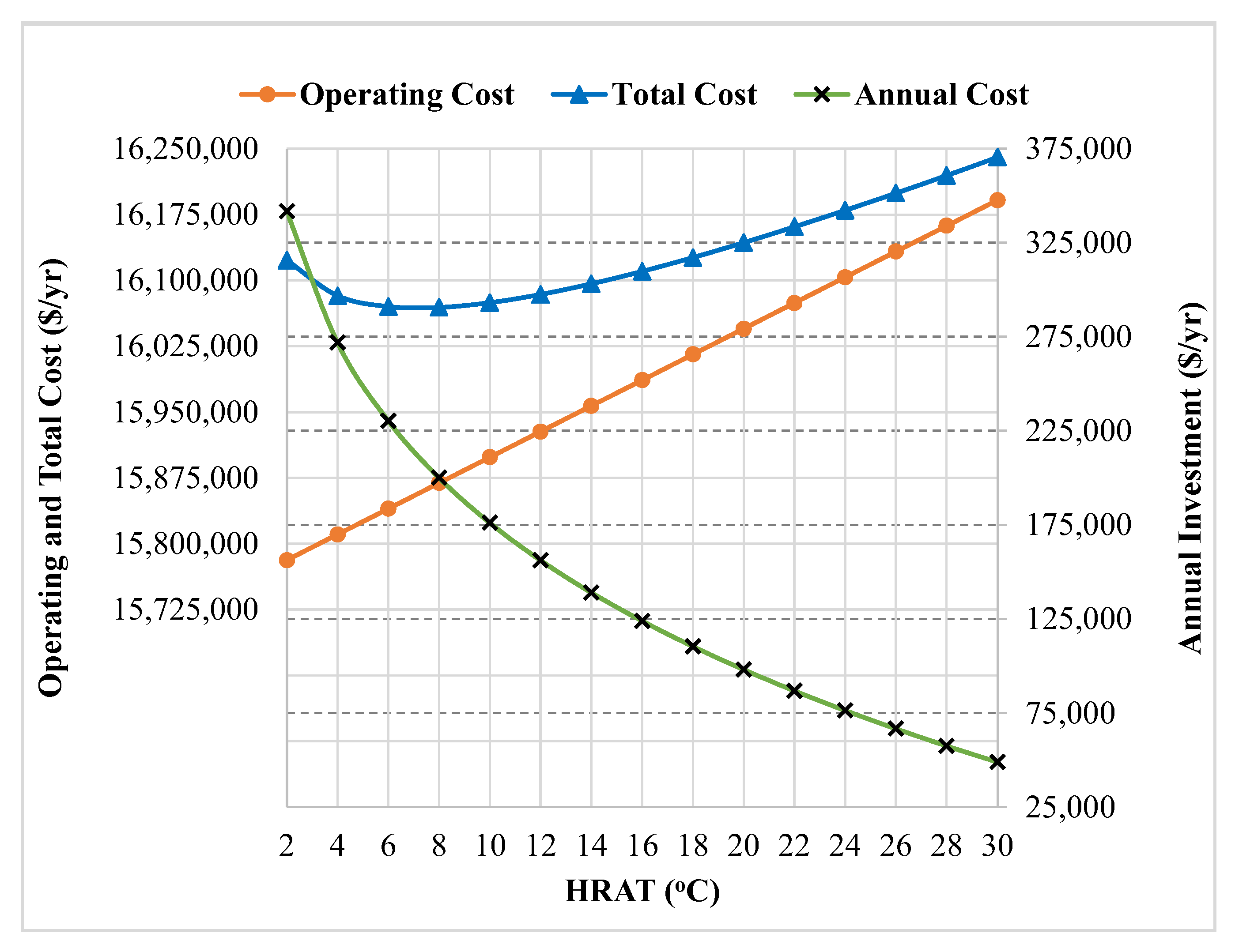
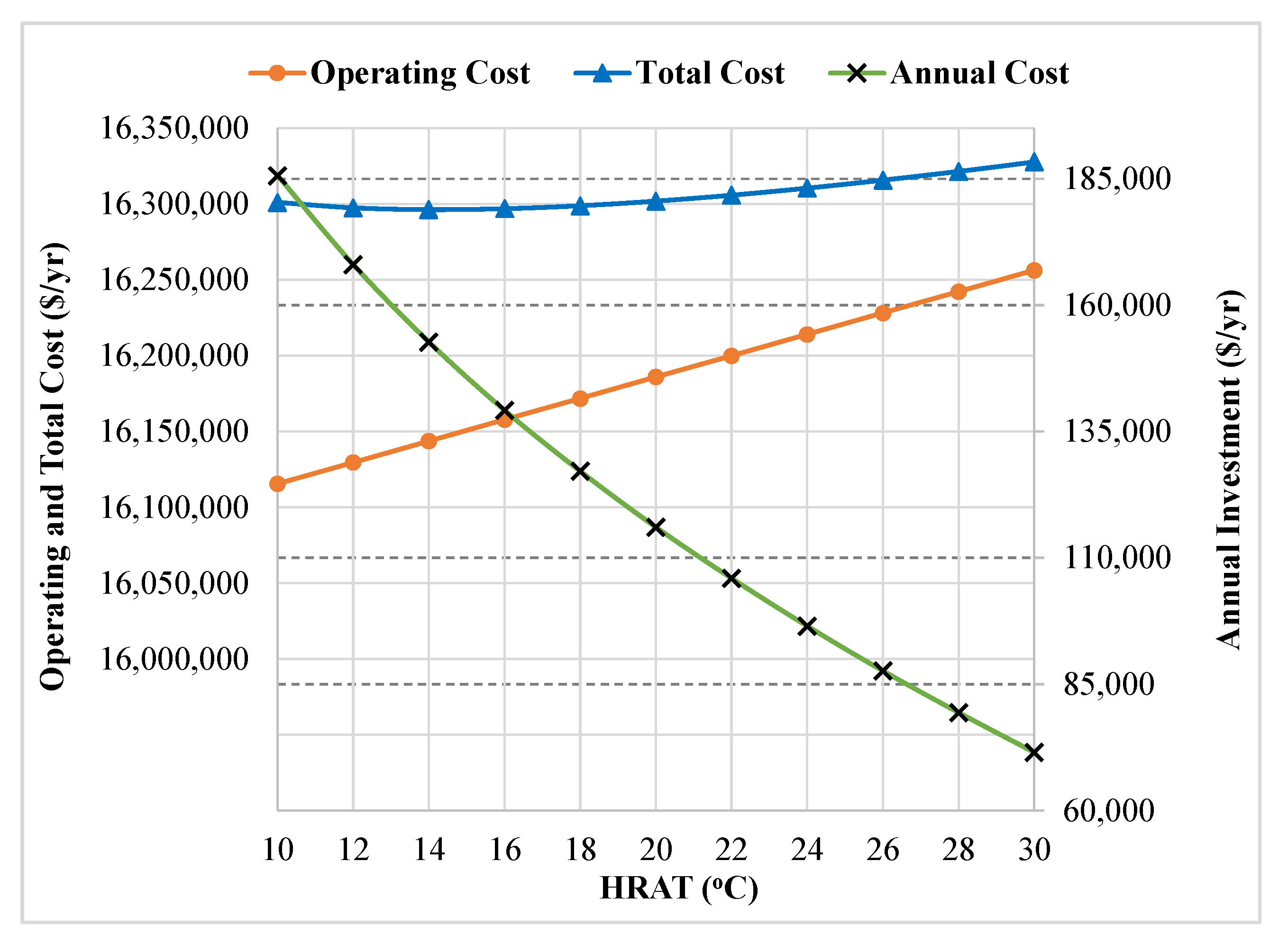
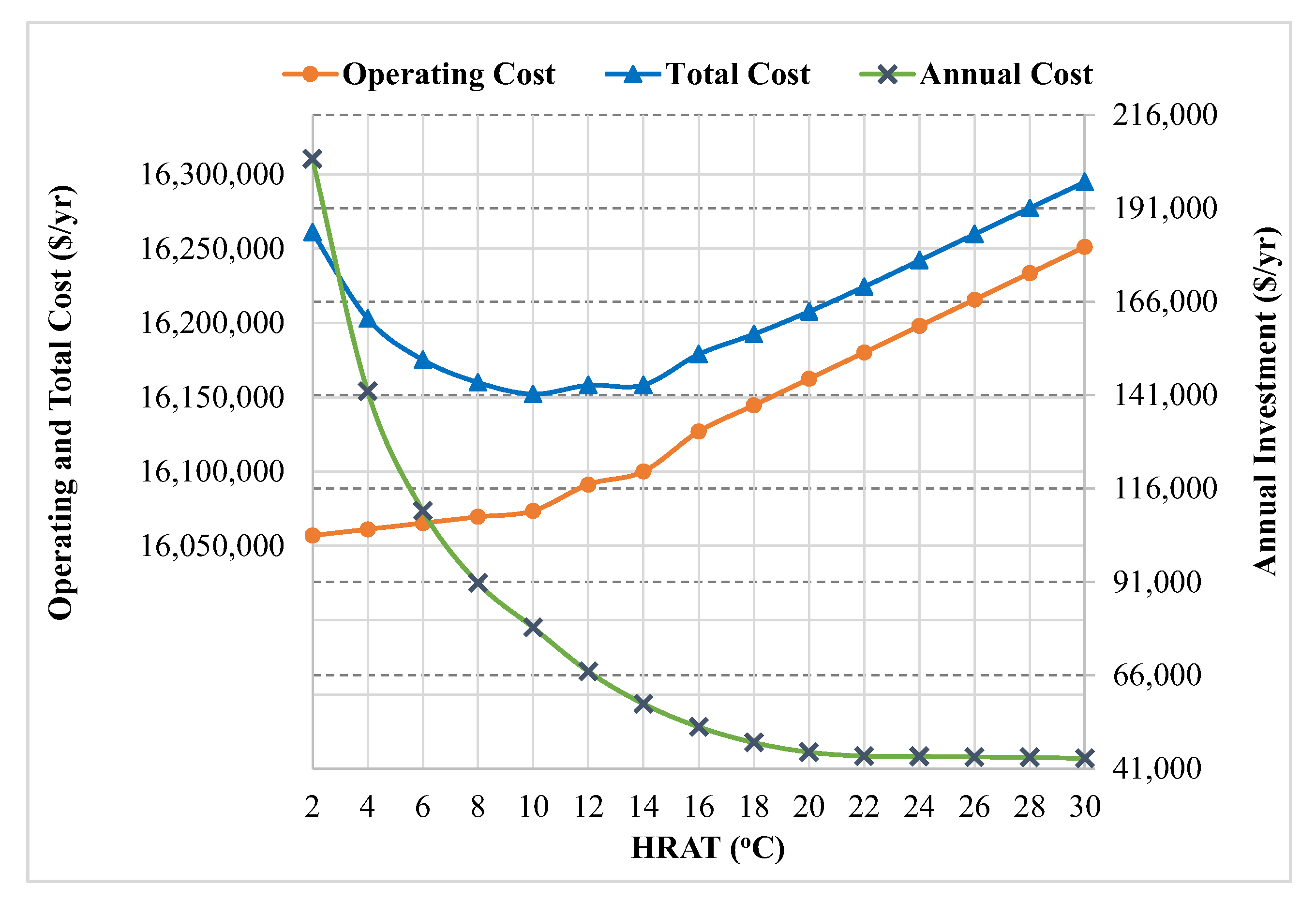



| Stream | Fluid | Exchanger’s Side | AE (m2) | QE (kW) | hT (kW/m2·°C) | hS (kW/m2·°C) |
|---|---|---|---|---|---|---|
| 1 | Kerosene | E6, Shell side | 280 | 6000 | - | 0.4922 |
| 2 | LGO | E3, Shell side | 800 | 15,000 | - | 0.4778 |
| 3 | HGO | E4, Shell side | 280 | 7500 | - | 0.4389 |
| 4 | ATB | E1, Shell side | 1360 | 22,000 | - | 0.4704 |
| 5 | Naphtha | E5, Shell side | 1480 | 23,000 | - | 0.5615 |
| 6 | BPA | E2, Shell side | 2760 | 38,480 | - | 0.4922 |
| 7 | Crude | E1-E6, Tube side | - | - | 0.343 | - |
| Utility Device | QH and QC (kW) | HUprice and CUprice ($/kW) |
|---|---|---|
| H | 80,418 | 107 |
| C1 | 2970 | 10.7 |
| C2 | 11,312 | 21.04 |
| C3 | 3316 | 21.04 |
| C4 | 26,048 | 21.04 |
| C5 | 9890 | 10.7 |
| Path No. | Path Name | Path Description |
|---|---|---|
| 1 | A | H → E6 → C1 |
| 2 | B | H → E5 → C5 |
| 3 | C | H → E4 → C3 |
| 4 | D | H → E3 → C2 |
| 5 | E | H → E1 → C4 |
| 6 | F | C2 → E3 → E6 → C1 |
| 7 | G | C2 → E3 → E5 → C5 |
| 8 | H | C3 → E4 → E6 → C1 |
| 9 | I | C3 → E4 → E5 → C5 |
| 10 | J | C4 → E1 → E6 → C1 |
| 11 | K | C4 → E1 → E5 → C5 |
| Options | Combined Paths | HEN Devices (Exchangers, Heaters, Coolers) | |||||||||||
|---|---|---|---|---|---|---|---|---|---|---|---|---|---|
| H1 | E1 | E2 | E3 | E4 | E5 | E6 | C1 | C2 | C3 | C4 | C5 | ||
| Opt 1 | D E | - | + | - | |||||||||
| - | + | - | |||||||||||
| Opt 2 | A B C | - | + | - | |||||||||
| - | + | - | |||||||||||
| - | + | - | |||||||||||
| Opt 3 | A B J K | - | + | - | |||||||||
| - | + | - | |||||||||||
| + | - | + | - | ||||||||||
| + | - | - | + | ||||||||||
| Opt 4 | A B C D E | - | + | - | |||||||||
| - | + | - | |||||||||||
| - | + | - | |||||||||||
| - | + | - | |||||||||||
| - | + | - | |||||||||||
| Opt 5 | A F B C D E | - | + | - | |||||||||
| + | - | + | - | ||||||||||
| - | + | - | |||||||||||
| - | + | - | |||||||||||
| - | + | - | |||||||||||
| - | + | - | |||||||||||
| Options of Combined Paths | HRAT Value | Area Targeting, AHEN (m2) | ||
|---|---|---|---|---|
| Previous Work | Present Work (Optimum HRAT) | Previous Work | Present Work | |
| DE | Assumed one value for all options, 27 °C | 8 | 7300 | 8449 |
| ABC | 14 | 7210 | 7623 | |
| ABJK | 10 | 7100 | 7696 | |
| ABCDE | 14 | 7210 | 7623 | |
| AFBCDE | 10 | 7180 | 7894 | |
Publisher’s Note: MDPI stays neutral with regard to jurisdictional claims in published maps and institutional affiliations. |
© 2022 by the authors. Licensee MDPI, Basel, Switzerland. This article is an open access article distributed under the terms and conditions of the Creative Commons Attribution (CC BY) license (https://creativecommons.org/licenses/by/4.0/).
Share and Cite
Osman, A.; Mirghani, M.S. Energy Savings in the Heat Exchanger Network of an Oil Refinery Pre-Heat Train Unit Using a Path’s Combination at Different HRAT Values. Processes 2022, 10, 2541. https://doi.org/10.3390/pr10122541
Osman A, Mirghani MS. Energy Savings in the Heat Exchanger Network of an Oil Refinery Pre-Heat Train Unit Using a Path’s Combination at Different HRAT Values. Processes. 2022; 10(12):2541. https://doi.org/10.3390/pr10122541
Chicago/Turabian StyleOsman, Abdelbagi, and Mousab Salaheldeen Mirghani. 2022. "Energy Savings in the Heat Exchanger Network of an Oil Refinery Pre-Heat Train Unit Using a Path’s Combination at Different HRAT Values" Processes 10, no. 12: 2541. https://doi.org/10.3390/pr10122541
APA StyleOsman, A., & Mirghani, M. S. (2022). Energy Savings in the Heat Exchanger Network of an Oil Refinery Pre-Heat Train Unit Using a Path’s Combination at Different HRAT Values. Processes, 10(12), 2541. https://doi.org/10.3390/pr10122541







